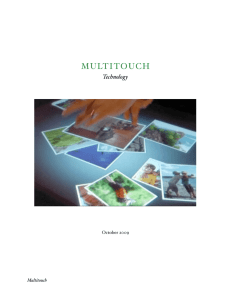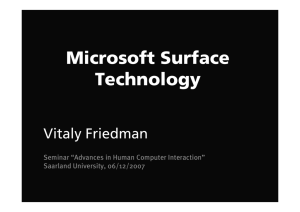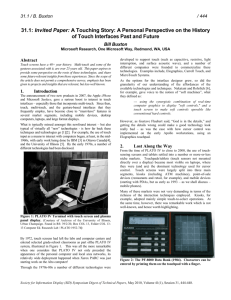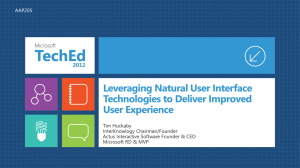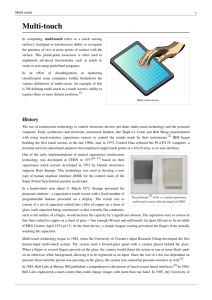Multi-touch - ZEN Portfolios
advertisement
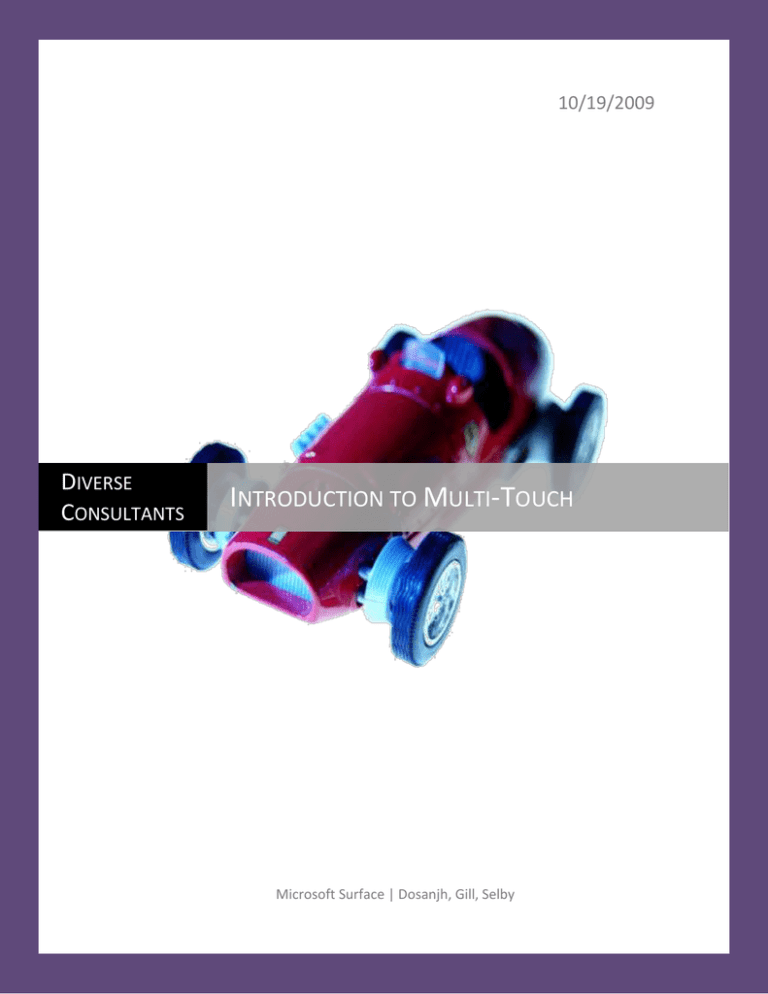
10/19/2009 DIVERSE CONSULTANTS INTRODUCTION TO MULTI-TOUCH Microsoft Surface | Dosanjh, Gill, Selby Introduction to Multi-Touch Table of Contents Attribution ................................................................................................................................ 3 Our Contribution ....................................................................................................................... 3 Wikipeda ................................................................................................................................... 4 Creative Commons .................................................................................................................... 4 Multi-touch ............................................................................................................................... 5 History ....................................................................................................................................... 6 Multi-touch displays ................................................................................................................. 7 Perceptive Pixel..................................................................................................................... 7 Microsoft Surface.................................................................................................................. 7 3M Multi-touch ..................................................................................................................... 7 Tyco Electronics: Elo Touch Systems .................................................................................... 7 Demand Evolution ................................................................................................................ 8 MultiTouch LCD Cell .............................................................................................................. 8 HP TouchSmart ..................................................................................................................... 8 Multi-touch pads....................................................................................................................... 9 Fingerworks........................................................................................................................... 9 Apple products ...................................................................................................................... 9 CUBIT and TouchKit .............................................................................................................. 9 Asus EEE PC ........................................................................................................................... 9 Dell Inspiron Mini .................................................................................................................. 9 Notebooks and tablets ............................................................................................................ 11 HP Touchsmart TX2 ............................................................................................................. 11 Dell Latitude XT/XT2 ........................................................................................................... 11 Sharp Mebius ...................................................................................................................... 11 Lenovo Tablets (x200) ......................................................................................................... 11 Lenovo Tablets (x400) ......................................................................................................... 11 Software .................................................................................................................................. 12 Mac OS X Tiger .................................................................................................................... 12 Linux .................................................................................................................................... 12 Windows 7 .......................................................................................................................... 12 Multi-touch for Java (MT4j) ................................................................................................ 12 2|Page Introduction to Multi-Touch 22MILES .............................................................................................................................. 12 Popular culture references ..................................................................................................... 13 Microsoft Surface.................................................................................................................... 14 Overview ................................................................................................................................. 15 History ..................................................................................................................................... 16 Features .................................................................................................................................. 17 Specifications .......................................................................................................................... 18 Applications development ...................................................................................................... 19 Second generation .................................................................................................................. 20 Attribution All the content in this report, except for the Top Web Links section is from Wikipedia, licensed under the Creative Commons Share-Alike 3.0 Unported License (see below for an overview of both Wikipedia and the Creative Commons). The following picture shows the full license below (it is also set up as a hyperlink to the original web source for this license). (Wikipedia, 2009) Figure 1 – Wikipedia Creative Commons License Our Contribution We have attempted to add extra value to the content by structuring it in an easy to read, business report format and to add an informative “Top Web Links” section. We have also 3|Page Introduction to Multi-Touch added an index to help you find what you are looking for. We hope you find it useful and worth the $1 purchase price. We have prepared this report as part of a MS Word 2007 assignment for BSYS 1000 – Computer Applications I that we are taking at the British Columbia Institute of Technology (BCIT). All proceeds will go to student clubs within the School of Business at BCIT. Wikipeda Wikipedia is a multilingual, Web-based, free-content encyclopedia project based mostly on anonymous contributions. The name “Wikipedia” is a portmanteau of the words wiki (a type of collaborative Web site) and encyclopedia. Wikipedia’s articles provide links to guide the user to related pages with additional information. Wikipedia is written collaboratively by an international (and mostly anonymous) group of volunteers. Anyone with internet access can write and make changes to Wikipedia articles. There are no requirements to provide one’s real name when contributing; rather, each writer’s privacy is protected unless they choose to reveal their identity themselves. Since its creation in 2001, Wikipedia has grown rapidly into one of the largest reference web sites, attracting around 65 million visitors monthly as of 2009. There are more than 75,000 active contributors working on more than 14,000,000 articles in more than 260 languages. As of today, there are 3,062,069 articles in English. Every day, hundreds of thousands of visitors from around the world collectively make tens of thousands of edits and create thousands of new articles to augment the knowledge held by the Wikipedia encyclopedia. (See also: Wikipedia:Statistics.) Creative Commons Creative Commons (CC) is a non-profit organization devoted to expanding the range of creative works available for others to build upon legally and to share. The organization has released several copyright-licenses known as Creative Commons licenses. These licenses allow creators to communicate which rights they reserve, and which rights they waive for the benefit of recipients or other creators. 4|Page Introduction to Multi-Touch Multi-touch Multi-touch (or multitouch) denotes a set of interaction techniques which allow computer or mobile users to control graphical user interface with more than one finger at either application or system level. The term Multi-Touch is a trademark of Apple, Inc. [1] Multi-touch consists of a touch screen (screen, overlay, table, wall, etc.) or touchpad, as well as software that recognizes multiple simultaneous touch points, as opposed to the single touchscreen (e.g. computer touchpad, ATM), which recognizes only one touch point. This effect is achieved through a variety of means, including: heat, finger pressure, high capture rate cameras, infrared light, optic capture, tuned electromagnetic induction, ultrasonic receivers, transducer microphones, laser rangefinders, and shadow capture.[2] Many products using multi-touch interfaces exist and are being developed. Multi-touch is used on portable devices including the Apple iPhone, HTC Hero, Microsoft's Zune HD, Samsung Memory, and the Palm Pre, as well as desktop products such as the Microsoft Surface and the DELL Latitude XT2. Hobbyists have developed extremely low cost touchscreen technologies using webcams, projection of image, and software that senses touch patterns via the webcam. Multi touch screens larger than 50" are possible at costs under $100 to $400 depending on the projector & equipment used. DIY multitouch screens of extremely large size (wall sized or larger) are also quite possible and very cheaply constructed and posted in numerous places on the web. 5|Page Introduction to Multi-Touch History Multi-touch technology dates back to 1982, when Nimish Mehta at the University of Toronto developed the first finger pressure multi-touch display.[3] In 1983, Bell Labs at Murray Hill published a comprehensive discussion of touch-screen based interfaces. [4] In 1984 Bell Labs engineered a touch screen that could change images with more than one hand. The group at the University of Toronto stopped working on hardware and moved on to software and interfaces, expecting that they would have access to the Bell Labs work.[3] A breakthrough occurred in 1991, when Pierre Wellner published a paper on his multi-touch “Digital Desk”, which supported multi-finger and pinching motions. [5][6] Various companies expanded upon these discoveries in the beginning of the twenty-first century. Mainstream exposure to multi-touch technology occurred in the year 2007, when Apple unveiled the iPhone and Microsoft debuted surface computing. The iPhone in particular has spawned a wave of interest in multi-touch computing, since it permits greatly increased user interaction on a small scale. More robust and customizable multi-touch and gesture-based solutions are beginning to become available, among them TrueTouch, created by Cypress Semiconductor. The following is a compilation of notable uses of multitouch technology in recent years. The use of multi-touch technology is expected to rapidly become common place. For example, touch screen telephones are expected to increase from 200,000 shipped in 2006, to 21 million in 2012.[7] 6|Page Introduction to Multi-Touch Multi-touch displays Perceptive Pixel Perceptive Pixel is a company founded by New York University consulting research scientist Jefferson Y. Han that creates wall displays and tables. The displays use infrared light emitting diodes along with an infrared camera to determine the point of contact. Han envisions large collaborative spaces that will allow multiple users to work and interact. Perceptive Pixel’s technology is currently being utilized, in the form of the Multi-Touch Collaboration Wall, by CNN and an unspecified government contractor.[8] But its 6-figure price[9] even scared most interested medium business away. Microsoft Surface In 2001 Steve Bathiche and Andy Wilson of Microsoft began work on an idea for an interactive table that mixes both physical and virtual worlds. Research and Development expanded rapidly in 2004, once the idea caught the attention of Microsoft Chairman Bill Gates. In 2007 Microsoft introduced Microsoft Surface, a functional multi-touch table-top computer based on a standard PC platform including an Intel Core 2 Duo processor, Windows Vista, and 2 GB of RAM.[10] Essentially, Microsoft Surface is a computer embedded in a table with a large, flat, touchresponsive display on the top. The table uses small cameras (as opposed to finger pressure or heat) that enable it to react to the touch of any object. The unit has eight different modes that allow users to perform an array of activities,ranging from organizing pictures and videos to ordering food at a restaurant. Multiple users have the ability to work on the table at one time. The preliminary launch was on April 17, 2008, when Surface became available for customer use in AT&T stores. Although the product is not available for widespread purchase, it can possibly be bought directly from Microsoft for $13,500.[11] 3M Multi-touch 3M is a company known for many innovations in the touch field, including overlays incorporated in other vendor's products. 3M provides a Multi-touch developer kit which includes a projected capacitive glass surfaced 19" monitor with stand and a software development kit which includes support for the upcoming Windows 7 operating system. The unique features at this price point are 10 finger multi-touch and 15ms touch response with full edge support and finger identification when both are touching. [12] However, as the points increase on the screen, the screen sampling rate dramatically goes down. Tyco Electronics: Elo Touch Systems Tyco Electronics is an electronics component manufacturer which also sells touch technology through their Elo Touch Systems division. Elo Touch Systems provides integrator components, custom solutions, kits, and fully integrated touch monitors through resellers. Elo Touch Systems provides multiple technologies for single touch screens: Acoustic Pulse Recognition (APR); IntelliTouch Surface Acoustic Wave (SAW); and CarrollTouch InfraRed 7|Page Introduction to Multi-Touch (IR). For Multi-touch they have been an early integrator working on Microsoft Windows 7, initially announcing support for 2 finger multi-touch support with IntelliTouch Surface Acoustic Wave and technology built on CarrollTouch IR touch technologies, in both 19" and 22" form factors. [13]. Demand Evolution Demand Evolution has released two multi-touch displays based on infrared vision sensing and open-source software. Its product, the LCD based Gecko, is one of the cross platform, high-resolution multitouch displays available directly for consumers. The interactive display utilizes a 30" LCD, and as opposed to the wall mount and table designs of many competitors the Gecko is designed for workstation and kiosk scenarios. Currently, such open source multi-touch units on the market are low cost, because no developer kit, business software, or OS can directly support. It is aimed only at the open-source developer community and early adopters hoping to get in early on the industry shift to multi-touch interaction. MultiTouch LCD Cell In September 2008, MultiTouch Oy launched a large-scale LCD-based multitouch display, the MultiTouch Cell. This model was a 46-inch display with full-HD LCD panel. The central point of the LCD-based display is to handle the shortcomings of projector-based displays (poor contrast and resolution, frequent maintenance needs). HP TouchSmart HP Touchsmart is an All-In-One PC introduced by computer giant Hewlett-Packard and was first released in 2007. It is HP's first "PC-In-A-Box" computer, quite similar to the iMac G3, released in 1998, although incorporating a multi-touch display. It is the first mass marketed 'touch screen' PC made commercially available. The technology behind the first generation TouchSmart, however, does not support the same class of multi-touch interaction as the previously mentioned products. Because of the nature of its optical touch sensors, the display can not effectively sense touches that fall within the same sensing beam. This shadowing problem makes the screens prohibitive for many of the multi-touch interaction scenarios that other options can support. Newer generation TouchSmart systems feature larger display sizes, up to 25.5", and improved touch technology. The improvements confine the "area of confusion" to a smaller footprint, inhibiting multi-touch by very small fingers immediately adjacent to each other. 8|Page Introduction to Multi-Touch Multi-touch pads Fingerworks In 1999, Fingerworks, a Newark-based company run by University of Delaware academics John Elias and Wayne Westerman, produced a line of multi-touch products including the iGesture Pad and the TouchStream keyboard.[3] Westerman published a dissertation in 1999 on the subject. In 2005, after years of maintaining a niche line of keyboards and touchpads, Fingerworks was acquired by Apple Inc. Apple products In 2005, Apple acquired Fingerworks. In 2007 they introduced the iPhone, marking the first time multi-touch technology was used on a phone. The iPhone includes such components as a web browser, music player, video player, and a cell phone without the use of a hard keypad or stylus. Following the release of the iPhone, Apple also expanded its use of multi-touch computing with the new iPod Touch, as well as the new MacBook Air. As of 2008, Multi-touch can be found on the MacBook and MacBook Pro line in the form of a trackpad. The latest revisions of Apple's Unibody MacBook and MacBook Pro features a full glass multi-touch trackpad (whilst the MacBook Air features a standard multi-touch trackpad). These enable various gestures such as scrolling, "swiping" between pages or pictures as well as rotating pictures, and launching Expose.[14] CUBIT and TouchKit Addie Wagenknecht and Stefan Hechenberger of Nortd studio, based in New York and Vienna, created a scaled-down open-source version of Surface, called CUBIT and a screen based kit called TouchKit. According to the website of Technology Review magazine, "By sharing the Cubit's hardware schematics and software source code, the engineers are significantly reducing the cost of owning a multitouch table. But they're also fostering innovation by giving engineers an open platform on which to develop novel multitouch applications--something that they've previously lacked. It will cost anywhere between $1,000 to $1,580 depending on hardware used." [15] Asus EEE PC Asus has included a multi-touch touchpad in the 900 and 1000 series of their Eee PC netbooks, an Elantech Smart-Pad. Depending on the installed drivers, it can be used for scrolling, 3 button operation, dragging and resizing and rotating pictures. Dell Inspiron Mini Dell has also included a multi-touch touchpad in the Dell Inspiron Mini Series. Provided with a driver from Elantech, it can be used for scrolling, 3 button operation, dragging, resizing, rotating pictures and system shortcuts as Start Menu and Explorer (on Windows), browser 9|Page Introduction to Multi-Touch back and forward, minimizing and maximizing windows, window switching, desktop showing and hiding, and running custom commands. 10 | P a g e Introduction to Multi-Touch Notebooks and tablets HP Touchsmart TX2 Released in December 2008, the Touchsmart tx2 was touted as the first consumer notebook and tablet PC with on-screen multi-touch control. The tx2 features multi-touch technology by N-trig.[16], which also allows use of a stylus. Dell Latitude XT/XT2 In July 2008, Dell released multi-touch touch-screen drivers for the Latitude XT Tablet, claiming the "industry’s first convertible tablet with multi-touch capabilities."[17] Dell has partnered with multi-touch technology startup N-trig to enable multi-touch capabilities for its tablet. [18] There have been numerous reports of serious problems with the XT multi-touch drivers or hardware interface, which, as of October 2008, remain unresolved by Dell.[19] The major issue is centered around the multi-touch drivers failing when the computer is booted when USB devices are connected at boot, or when certain internal media drives are present. Often, but not always, the issue is resolved if the computer is booted without the USB devices and they are connected after boot.[20] A similar, but not identical, issue may also be caused by interfering software, such as the iTunes helper.[21] Issue resolution is complicated by the possible failure of the driver install program to function in the presence of damaged drivers, requiring manual removal of related files and registry keys..[22] See External Links for links to user discussions of this issue. With the introduction of Windows 7 which offers native multi-touch support, preliminary tests have show that many of these issues with the XT have been solved, together with a much improved N-Trig Win 7 driver. Sharp Mebius In April 2009, Sharp unveiled the first laptop with an optical-sensor LCD pad. The opticalsensor LCD technology combines LCD and CCD elements within its pixels and can detect fingers and objects such as a stylus, and is claimed to be able to scan a business card placed on top of the screen. Further improvements to this function are expected to enable fingerprint authentication in the future.[23][24] Lenovo Tablets (x200) Currently, Lenovo's definition of "Multitouch" implies that the screen responds to either a finger or a digitizer pen.[25] However, it is not capable of detecting simultaneous touch points on the tablet screen nor any forms of multi-finger gestures, while the Windows 7 already supports simple dual-touch ones. Lenovo Tablets (x400) The upcoming new version of Lenovo's ThinkPad T400s will feature multi-touch by NTrig[26]. 11 | P a g e Introduction to Multi-Touch Software Mac OS X Tiger Apple Mac OS X 10.4, as well as derivatives such as iPhone OS support multi-touch. This extends from the windowing environment, through to Safari, iLife and other software. Linux Various versions of Linux, and especially those versions used on small devices such as the Asus Eee PC and Palm Pre, have multi-touch support. Windows 7 While previous versions of Windows do not support multi-touch screens, Windows 7 will support multi-touch when released.[27] The operating system is known to have a multitouch mapping application, photo viewing program, and incorporation in Internet Explorer 8. In January 2009, Microsoft joined with other investors who invested twenty-four million dollars in N-Trig Ltd., which plans to make computer hardware that takes advantage of Windows 7's multi-touch support.[28] Multi-touch for Java (MT4j) MT4j [29] is an open source multi-touch application development platform which is designed for rapid development of graphically rich multi-touch applications based on the Java programming language. It runs on common PC hardware and operating systems (Windows, Linux). Multi-touch hardware technology is abstracted via TUIO Protocol. MT4j provides a component model. Many multi-touch user interface components are already included. There is a support for common input formats (e.g. svg, 3ds, obj, various image formats) and OpenGL is used to provide high performance 2D and 3D graphics rendering. 22MILES One of the advantages of 22MILES multi-touch framework is OS and multi-touch hardware independent.[30] Their multi-touch software can run Windows 7, XP, Vista, Ubuntu Linux and Mac OS X, while it supports various multi-touch hardware technology, such as Infrared Matrix/Camera, Projected Capacitive, SAW (dual-touch), resistive, FTIR/ DI/ DSI, LED-LP. But unlike open-source, their proprietary software and multitouch gestures only target to business,[31] such as digital signage, Medical Industry, GIS, Real Estate, and so on. 12 | P a g e Introduction to Multi-Touch Popular culture references Pop culture has also portrayed potential uses of multi-touch technology in the future. The 2002 science-fiction film Minority Report showed different Multi-touch features like enlarging and moving objects around. The television series CSI: Miami introduced both surface and wall displays similar to Microsoft Surface in its sixth season. Another form of a multi-touch computer was seen in the motion picture starring Ewan McGregor The Island, where the professor played by Sean Bean has a multi-touch desktop to organize files, which was based on an early version of Microsoft Surface[9]. This technology can also be seen in the James Bond film Quantum of Solace. In a parodic episode of the popular TV series The Simpsons, when Lisa Simpson travels to the underwater headquarters of Mapple to visit Steve Mobs, the erstwhile pretender to the throne of Apple is shown to be performing multiple multi-touch hand gestures on a large touch wall. A device similar to the Surface was seen in the 1982 movie Tron. It took up an executive's entire desk and was used to communicate with the Master Control computer. 13 | P a g e Introduction to Multi-Touch Microsoft Surface Microsoft Surface (codename Milan) is a multi-touch product from Microsoft which is developed as a software and hardware combination technology that allows a user, or multiple users, to manipulate digital content by the use of natural motions, hand gestures, or physical objects. It was announced on May 29, 2007 at D5 conference.[2] Initial customers will be in the hospitality businesses, such as restaurants, hotels, retail, public entertainment venues and the military for tactical overviews. The preliminary launch was on April 17, 2008, when Surface became available for customer use in AT&T stores.[1] The Surface was used by MSNBC during its coverage of the 2008 US presidential election;[3] and is also used by Disneyland’s future home exhibits, as well as various hotels and casinos. The Surface is also featured in the CBS series CSI: Miami and EXTRA! Entertainment news. As of March 2009, Microsoft had 120 partners in 11 countries that are developing applications for Surface's interface.[4] 14 | P a g e Introduction to Multi-Touch Overview Microsoft Surface is a surface computing platform that responds to natural hand gestures and real world objects. It has a 360-degree user interface, a 30-inch reflective surface with a XGA DLP projector underneath the surface which projects an image onto its underside, while four cameras in the machine's housing record reflections of infrared light from objects and human fingertips on the surface. The surface is capable of object recognition, object/finger orientation recognition and tracking, and is multi-touch and is multi-user. Users can interact with the machine by touching or dragging their fingertips and objects such as paintbrushes across the screen, or by placing and moving placed objects. This paradigm of interaction with computers is known as a natural user interface (NUI). Surface has been optimized to respond to 52 touches at a time. During a demonstration with a reporter, Mark Bolger, the Surface Computing group's marketing director, "dipped" his finger in an on-screen paint palette, then dragged it across the screen to draw a smiley face. Then he used all 10 fingers at once to give the face a full head of hair. Using the specially-designed barcode-style "Surface tags" on objects, Microsoft Surface can offer a variety of features, for example automatically offering additional wine choices tailored to the dinner being eaten based on the type of wine set on the Surface, or in conjunction with a password, offering user authentication. A commercial Microsoft Surface unit is $12,500 (unit only), whereas a developer Microsoft Surface unit costs $15,000 and includes a developer unit, five seats and support.[5] However Microsoft said it expects prices to drop enough to make consumer versions feasible in 2010.[6] Partner companies use the Surface in their hotels, restaurants, and retail stores. The Surface is used to choose meals at restaurants, plan vacations and spots to visit from the hotel room. Starwood Hotels plan to allow users to drop a credit card on the table to pay for music, books, and other amenities offered at the resort. In AT&T stores, use of the Surface include interactive presentations of plans, coverage, and phone features, in addition to dropping two different phones on the table and having the customer be able to view and compare prices, features, and plans. MSNBC's coverage of the 2008 US presidential election used Surface to share with viewers information and analysis of the race leading up to the election. The anchor analyzes polling and election results, views trends and demographic information and explores county maps to determine voting patterns and predict outcomes, all with the flick of his finger. In some hotels and casinos, users can do a range of things, such as watch videos, view maps, order drinks, play games, and chat and flirt with people between Surface tables. 15 | P a g e Introduction to Multi-Touch History The technology behind Surface is called multi-touch and has at least a 25-year history,[7] beginning in 1982, with pioneering work being done at the University of Toronto (multitouch tablets) and Bell Labs (multi-touch screens). The product idea for Surface was initially conceptualized in 2001 by Steven Bathiche of Microsoft Hardware and Andy Wilson of Microsoft Research.[8] In October 2001, a virtual team was formed with Bathiche and Wilson as key members, to bring the idea to the next stage of development. In 2003, the team presented the idea to the Microsoft Chairman Bill Gates, in a group review. Later, the virtual team was expanded and a prototype nicknamed T1 was produced within a month. The prototype was based on an IKEA table with a hole cut in the top and a sheet of architect vellum used as a diffuser. The team also developed some applications, including pinball, a photo browser and a video puzzle. Over the next year, Microsoft built more than 85 early prototypes for Surface. The final hardware design was completed in 2005. A similar concept was used in the 2002 science fiction movie Minority Report . As noted in the DVD commentary, the director Steven Spielberg stated the concept of the device came from consultation with Microsoft during the making of the movie. One of the film's technology consultant's associates from MIT later joined Microsoft to work on the Surface project.[9] Surface was unveiled by Microsoft CEO Steve Ballmer on May 30, 2007 at The Wall Street Journal's 'D: All Things Digital' conference in Carlsbad, California.[10] Surface Computing is part of Microsoft's Productivity and Extended Consumer Experiences Group, which is within the Entertainment & Devices division. The first few companies to deploy Surface will include Harrah's Entertainment, Starwood Hotels & Resorts Worldwide, T-Mobile and a distributor, International Game Technology.[11] On April 17, 2008 AT&T became the first retail location to launch Surface.[12] In June 2008 Harrah’s Entertainment launched Microsoft Surface at Rio iBar[13] and Disneyland launched it in Tomorrowland, Innoventions Dream Home[14]. On August 13, 2008 Sheraton Hotels introduced Surface in their hotel lobbies at 5 locations[15]. On September 8, 2008 MSNBC began using the Surface to work with election maps for the 2008 US Presidential Election on air. MSNBC's political director, Chuck Todd, was placed at the helm. 16 | P a g e Introduction to Multi-Touch Features Microsoft notes four main components being important in Surface's interface: direct interaction, multi-touch contact, a multi-user experience, and object recognition. Direct interaction refers to the user's ability to simply reach out and touch the interface of an application in order to interact with it, without the need for a mouse or keyboard. Multitouch contact refers to the ability to have multiple contact points with an interface, unlike with a mouse, where there is only one cursor. Multi-user is a benefit of multi-touch -several people can orient themselves on different sides of the surface to interact with an application simultaneously. Object recognition refers to the device's ability to recognize the presence and orientation of tagged objects placed on top of it. The technology allows non-digital objects to be used as input devices. In one example, a normal paint brush was used to create a digital painting in the software.[16] This is made possible by the fact that, in using cameras for input, the system does not rely on restrictive properties required of conventional touchscreen or touchpad devices such as the capacitance, electrical resistance, or temperature of the tool used (see Touchscreen). The computer's "vision" is created by a near-infrared, 850-nanometer-wavelength LED light source aimed at the surface. When an object touches the tabletop, the light is reflected to multiple infrared cameras with a net resolution of 1024 x 768, allowing it to sense, and react to items touching the tabletop. Surface will ship with basic applications, including photos, music, virtual concierge, and games, that can be customized for the customers.[17] A unique feature that comes preinstalled with Surface is the pond effect "Attract" application. Simply, it is a "picture" of water with leaves and rocks within it (a lot like a screen saver used in Windows XP or Vista). By touching the screen, you can create ripples in the water just like you were putting your hand into a real stream. Additionally, the pressure of touch alters the size of the ripple created, and objects placed into the water create a barrier that ripples bounce off, just as they would in real life. 17 | P a g e Introduction to Multi-Touch Specifications Surface is a 30-inch (76 cm) display in a table-like form factor, 22 inches (56 cm) high, 21 inches (53 cm) deep, and 42 inches (107 cm) wide.[17]. The Surface tabletop is acrylic, and its interior frame is powder-coated steel. The software platform runs on a custom version of Windows Vista and has wired Ethernet 10/100, wireless 802.11 b/g, and Bluetooth 2.0 connectivity.[17] Surface applications are written using either Windows Presentation Foundation or Microsoft XNA technology.[18] At Microsoft's MSDN Conference, Bill Gates told developers of "Maximum" setup the Microsoft Surface was going to have: Intel Core Quad Xeon "WoodCrest" @ 2.66GHz with a custom motherboard form factor about the size of two ATX motherboards. 4GB DDR2-1066 RAM 1TB 7200RPM Hard Drive However, the current commercially available version has the following specifications[19]: Intel Core 2Duo @ 2.13GHz (normal motherboard) 2GB DDR2 RAM 250GB Sata Hard Drive 18 | P a g e Introduction to Multi-Touch Applications development Microsoft Surface applications can be written in Windows Presentation Foundation or XNA. The development process is much like normal Vista development, but custom WPF controls had to be created by the Surface team due to the unique interface of Surface. Developers already proficient in WPF can utilize the SDK to write Surface apps for deployments for the large hotels, casinos, and restaurants. [20] 19 | P a g e Introduction to Multi-Touch Second generation Microsoft announced in March 2009 that a new generation of Microsoft Surface code named Second Light was in development.[21] The second generation Surface model will build on the original model and have a second projector inside the table computer that can project images onto a layer above the surface of the screen. The device will be able to overlay secondary images above those on the screen - such as satellite imagery over a street map, or more detailed contextual data on top of images. The machine will also have infrared sensors that can interpret gestures and movements without having to touch the screen. However, Second Light is still in the development stage and a date has not been confirmed for release. 20 | P a g e Resources Top Web Source What is a touch screen News about touch screen Inside information on apples latest touchscreen Timeline of touch screen Source Tech Report Cnet news Apple Insider URL http://techreport.com/discussions.x/17713 http://news.cnet.com/8301-13579_3-10161312-37.html http://www.appleinsider.com/articles/09/02/05/apples_snow_leopard_to_ Psskie Report Information about touch screen Latest Touch screen Cnet news Tech Vibes Future applications of touch screens Information about multi touch Microsoft’s futuristic touch screen entertainment center Report on latest touch screens A pixel company Wikipedia http://www.psfk.com/2009/05/offf-report-multi-touch-barcelona-share-ajourney-of-discovery.html http://www.cnet.com/8301-19736_1-10307673-251.html http://www.techvibes.com/blog/the-minority-report-future-is-almosthere-bumptop-multi-touch http://en.wikipedia.org/wiki/Minority_Report_(film) Wikipedia Wikipedia http://en.wikipedia.org/wiki/Multi-touch http://en.wikipedia.org/wiki/Microsoft_Surface TG Daily Perceptive Pixel http://www.tgdaily.com/content/view/43984/97/ http://www.perceptivepixel.com/ Table 1 – Top Web Sources. Introduction to Multi-Touch F finger pressure .............................................................................................. 5 O H one touch point............................................................................................. 5 optic capture ................................................................................................. 5 high capture rate cameras ............................................................................ 5 S I shadow capture.[ .......................................................................................... 5 infrared light ................................................................................................. 5 T L transducer microphones ............................................................................... 5 tuned electromagnetic induction ................................................................. 5 laser rangefinders ......................................................................................... 5 U ultrasonic receivers ....................................................................................... 5 22 | P a g e
